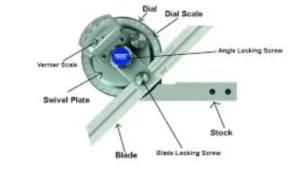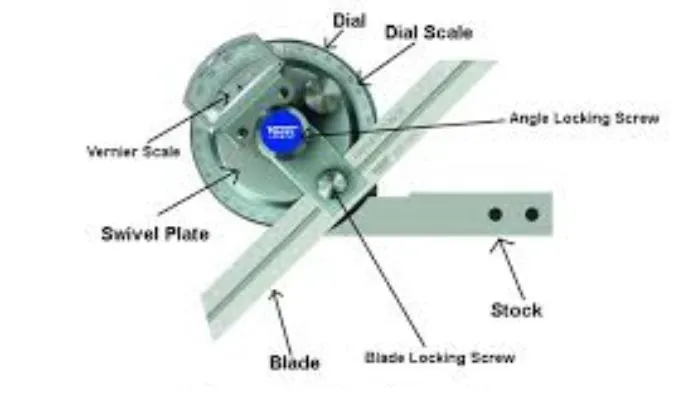Hello friends, Today we are going to talk about Vernier bevel protractor in which we will know parts of vernier bevel protractor, how to calculate least count of vernier bevel protractor, and at the last also know how to read Vernier bevel protractor.
Vernier bevel protractor is an angle measuring micrometers used to layout or check an angle of up to 5 minutes precision.
The Vernier Bevel Protractor features a design comprising a fixed stock and an adjustable blade equipped with a graduated dial. The graduations on the dial typically range from 0° to 90° or 0° to 180°. This instrument is designed to rotate freely at any angle around a circle and can be securely clamped into a specific position using a locking screw nut. It is a versatile tool that allows for precise angle measurements in various applications.
Now, let’s delve into the comprehensive details of the Vernier Bevel Protractor without further delay.
Definition of Vernier Bevel Protractor
The Vernier Bevel Protractor is a precision measuring instrument used for precisely determining angles in the range of 0 to 360 degrees. It consists of a fixed stock and an adjustable blade, both equipped with graduated scales. The instrument can be rotated freely around a circle and securely clamped into a desired position, making it suitable for applications where accurate angle measurements are crucial, such as in engineering, machining, and various technical fields. The graduated scales, often in degrees, allow users to read both the main scale and the fine scale (Vernier scale) to obtain highly accurate angular measurements.
Vernier bevel protractor is used to measure the angle of any job or workpiece.
This allows an angle of up to 5 minutes accuracy.
Parts of Vernier Bevel Protractor
There are the following parts of the Vernier bevel protractor:
- Stock
- Blade
- Disc
- Main Scale
- Dial
- Vernier Scale
- Locking Screw
- Magnifying Glass
In the context of a Vernier Bevel Protractor, the terms you’ve listed refer to various components of the instrument:

Stock
The fixed stock is the stationary part of the protractor that typically contains the main scale. It remains fixed during angle measurements, providing a stable reference.
Blade
The blade is the adjustable part of the protractor that carries the Vernier scale. It can be rotated freely to the desired angle for measurement.
Disc
The disc may refer to the circular plate or dial of the protractor. This disc often contains the main scale, which is graduated in degrees, providing a reference for initial angle measurements.
Main Scale
The main scale is typically located on the fixed stock or disc. It is graduated in degrees and serves as the primary scale for reading initial angle measurements.
Dial
The dial could refer to the circular plate or disc of the protractor that contains the main scale.
Vernier Scale
The Vernier scale is a fine scale attached to the adjustable blade. It allows for more precise readings by providing subdivisions of the main scale.
Locking Screw
The locking screw is a mechanism that secures the adjustable blade at a specific angle. It prevents unintended movement and ensures accuracy during measurements.
Magnifying Glass
The magnifying glass is an optional accessory sometimes included with Vernier Bevel Protractors. It is used to magnify the scale markings, making it easier for the user to read and interpret the measurements with greater precision.
These components work together to allow users to accurately measure angles using the Vernier Bevel Protractor, providing versatility and precision in angular measurements.
How to Calculate Least Count of Vernier Bevel Protractor?
The least count of a measuring instrument is the smallest measurement that can be obtained using that instrument. For a Vernier Bevel Protractor, the least count can be calculated using the following formula:
\[ \text{Least Count} = \frac{\text{Value of one Main Scale Division}}{\text{Total Number of Vernier Scale Divisions}} \]
Here’s how you can break down the calculation:
Determine the Value of One Main Scale Division
Read the main scale of the protractor and note the value of one main scale division in degrees. This value is typically indicated on the main scale.
Count the Total Number of Vernier Scale Divisions
Examine the Vernier scale and count the total number of divisions it covers. This is the total number of divisions on the Vernier scale that coincide with a certain number of divisions on the main scale.
Calculate the Least Count
Use the formula mentioned above to calculate the least count.
For example, if the main scale reading is in degrees and one main scale division is 1 degree, and the Vernier scale has 10 divisions that coincide with 9 main scale divisions, the least count would be calculated as:
\[ \text{Least Count} = \frac{1 \, \text{degree}}{10} = 0.1 \, \text{degree} \]
This means that the Vernier Bevel Protractor can measure angles with a minimum resolution of 0.1 degree. The smaller the least count, the more precise the instrument is for angle measurements.
How to Read Vernier Bevel Protractor?
Reading a Vernier Bevel Protractor involves interpreting the readings on both the main scale and the Vernier scale to determine the angular measurement. Here are step-by-step instructions on how to read a Vernier Bevel Protractor:
Align the Protractor
Place the Vernier Bevel Protractor on the surface or edge of the object whose angle you want to measure. Ensure that the base is flat and the blade or blade edge is aligned with the surface.
Read the Main Scale
Identify the main scale reading on the fixed stock or disc. This reading gives you the initial value of the angle.
Read the Vernier Scale
Examine the Vernier scale on the adjustable blade. Locate the line on the Vernier scale that best aligns with a line on the main scale. Note the value on the Vernier scale that corresponds to this alignment.
Calculate the Total Angle
Combine the main scale reading and the Vernier scale reading to calculate the total angle. Use the formula:
\[ \text{Total Angle} = \text{Main Scale Reading} + (\text{Vernier Scale Reading} \times \text{Least Count}) \]
Determine the Direction
Take note of the direction of the angle (clockwise or counterclockwise) based on the orientation of the instrument.
Final Reading
Combine the total angle and direction to get the final reading.
For example, if the main scale reading is 30 degrees, the Vernier scale reading is 25, and the least count is 1 degree, the total angle would be:
\[ \text{Total Angle} = 30 + (25 \times 1) = 55 \text{ degrees} \]
Remember to consider the direction, and the final reading would be 55 degrees in the specified direction.
Reading a Vernier Bevel Protractor requires careful alignment and interpretation of both scales to obtain accurate angular measurements. Practice and familiarity with the instrument are essential for precise readings.
Care and Maintenance of Vernier Bevel Protractor
Proper care and maintenance of a Vernier Bevel Protractor are essential to ensure accurate measurements and prolong the instrument’s lifespan. Here are some tips for the care and maintenance of a Vernier Bevel Protractor:
Storage
Store the protractor in a protective case or box when not in use to prevent dust, dirt, or damage.
Cleanliness
Keep the instrument clean by wiping it with a soft, lint-free cloth after each use. Remove any debris or foreign particles from the blades, scales, and other components.
Avoid Impact
Handle the protractor with care and avoid dropping it or subjecting it to sudden impacts, as this can affect its accuracy.
Blade Lubrication
If the Vernier Bevel Protractor has moving parts, consider applying a small amount of lubricant to the blades or rotating parts to ensure smooth movement. Follow the manufacturer’s recommendations for suitable lubricants.
Avoid Over-tightening
When using the locking screw to secure the adjustable blade, avoid over-tightening, as this can cause excessive wear or damage to the locking mechanism.
Calibration
Periodically check the calibration of the protractor using a known reference angle or a calibration standard. If necessary, consult the manufacturer’s guidelines for calibration procedures.
Inspect for Wear
Regularly inspect the blades, scales, and other components for signs of wear or damage. If any parts are worn or damaged, consider having the instrument serviced or repaired by a qualified technician.
Avoid Excessive Force
Avoid applying excessive force when measuring angles. Use the instrument with a gentle touch to prevent unnecessary wear on the blades and scales.
Environment
Store and use the Vernier Bevel Protractor in a clean and dry environment. Exposure to moisture or extreme temperatures should be minimized.
Professional Service
If the protractor is not functioning correctly or if you notice significant inaccuracies, consider sending it to the manufacturer or a qualified service center for professional inspection and maintenance.
By following these care and maintenance practices, you can ensure that your Vernier Bevel Protractor remains accurate and reliable over time, providing precise angle measurements for your applications.
Read also: Try Square: Parts, Types, Grades, Checking Accuracy, Uses
So here I discussed parts of vernier bevel protractor, how to calculate the least count of vernier bevel protractor, and also know how to read Vernier bevel protractor.
I hope you all enjoy this topic.
FAQ Related to Vernier Bevel Protractor
What is the accuracy of bevel protractor?
The accuracy of Vernier bevel protractor is 5 minutes.
What is the least count of Vernier bevel protractor?
The least count of the bevel protractors is 5 minutes.
What is the use of Vernier bevel protractor?
It is the commonly used for measuring an angle up to accuracy of 5 minutes.
What is the formula of Vernier bevel protractor least count?
Vernier bevel protractors least count formula are
Which part of Vernier bevel protractor is attached to disc?
A dial is the part of Vernier bevel protractor which is attached to the disc.
Which type of angle can be measure by Vernier bevel protractor?
All types of angle can be measured by it like acute angle, obtuse angle.
On Which principle Vernier bevel protractor work?
It is based on the difference of two analog scales. In which one is the Vernier scale and the other is the main scale.
